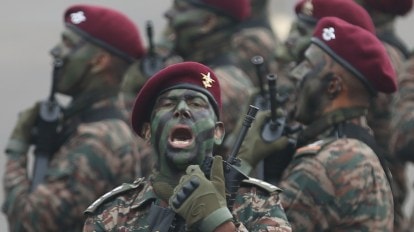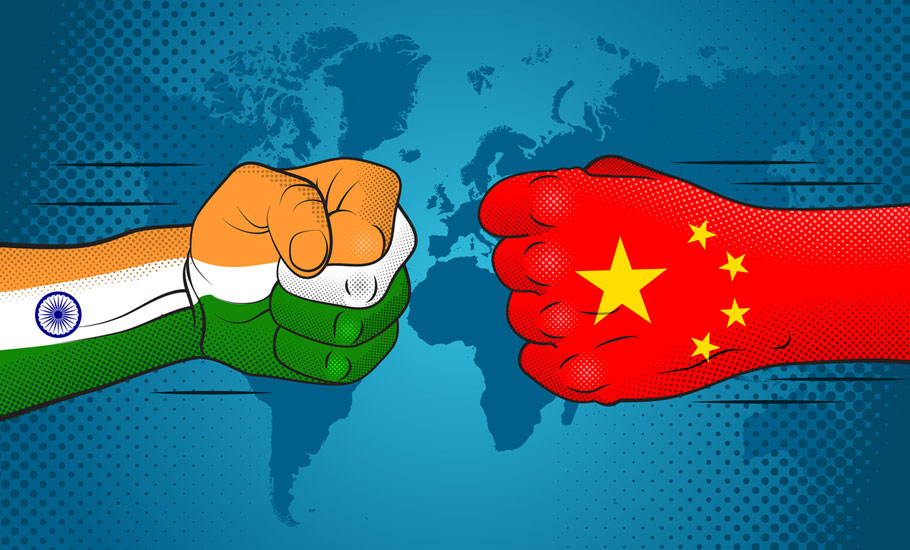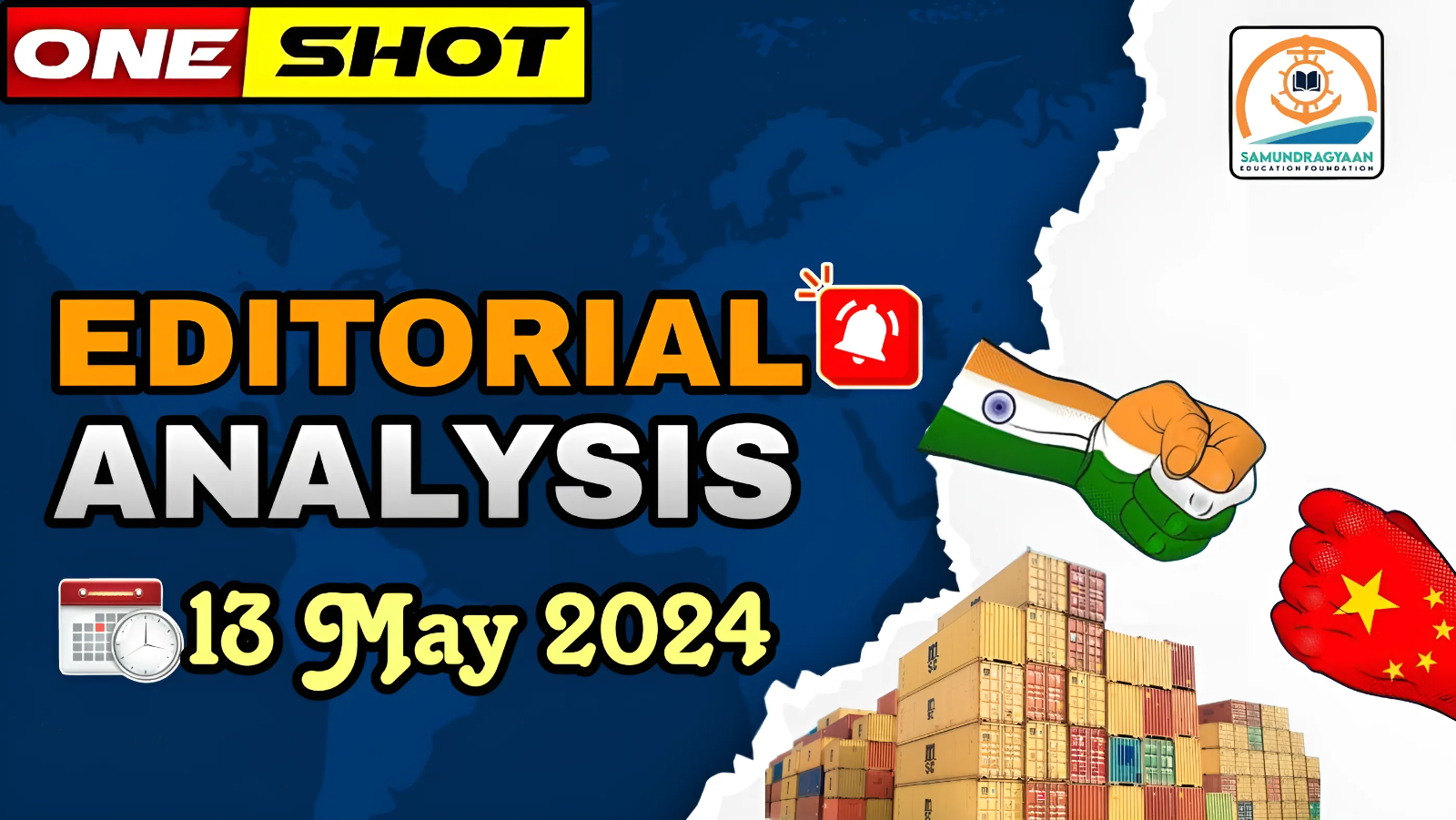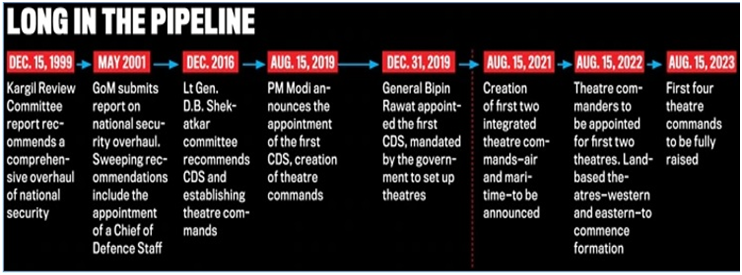Editorials and Articles : 13 May 2024

Why in news?
- The Armed Forces have finalized the structure for making integrated theater commands. They are now considering appointing a Vice Chief of Defence Staff and a Deputy Chief of Defence Staff.
What’s in today’s article?
- Theaterisation of Armed Forces
- Theatre commands and India
- Current command structure in India
- Recent steps taken by India towards theaterisation
- Proposed organisational structure for integrated theatre commands – key highlights
Theaterisation of Armed Forces
- It is a concept which seeks to integrate the capabilities of the three services – army, air force and navy – in order to optimally utilise their resources for wars and operations.
- A theatre command/unit will be created by integrating elements/assets from all the three services.
- Simply put, a theatre command deploys elements of the three services under a single, unified command structure.
- Each command is assigned a specific geographical region for operational roles.
- Almost all major countries like China, Russia, US, UK and France work on a theatre command concept.
- For example, China’s Western Theatre Command looks after the entire borders with India.
Theatre commands and India
- The Kargil Review Committee, the Naresh Chandra Committee and the Group of Ministers (GoM) had called for structural changes in higher defence management.
- It was the Shekatkar committee, which had recommended the creation of the post of Chief of Defence Staff (CDS) and theatre commands.
Current command structure in India
- At present, India has 17 single service commands and only two tri-service commands.
- The 17 single service commands are divided as:
- Army – 7 commands; Airforce – 7 commands; Navy – 3 commands
- The two tri-service commands are: Andaman and Nicobar Command (ANC), and The Strategic Force Command (handles the nuclear weapons).
- The Andaman and Nicobar command is a full-fledged command raised as a tri-service command in 2001.
Recent steps taken by India towards theaterisation
- Proposal to create a national defence committee
- There is a proposal for theatre commanders under a national defence committee likely to be headed by the Defence Minister.
- Inter-Services Organisation (Command, Control and Discipline) Act 2023
- The act empowers the commander-in-chief and the officer-in-command of inter-services organisations with disciplinary and administrative powers over personnel from the other services serving in them.
- Limited cross-postings between the Army, Navy and IAF have already been implemented to promote jointness.
- Restructuring of the headquarters and the subsequent postings will take place after the final approval from the govt.
- First tri-service common defence station
- In March 2024, the decision was taken to transform Mumbai into the first tri-service common defence station.
- A common defense station would merge all Army, Navy, and Air Force facilities, like logistics and maintenance, under one leadership.
- It was also decided to set up additional joint logistics nodes across the country to boost integration in logistical needs and streamline their supply chains.
- In March 2024, the decision was taken to transform Mumbai into the first tri-service common defence station.
Proposed organisational structure for integrated theatre commands – Key highlights
- Organisational structure for the creation of integrated theatre commands is ready
- The Armed Forces have finalised the organisational structure for the creation of integrated theatre commands.
- However, the organisational structure plan may be fine tuned after it gets government approval.
- Appointment of a Vice Chief of Defence Staff (CDS)
- The Vice CDS is likely to be an officer of the rank of General or equivalent.
- He is expected to look after strategic planning, capability development and procurement-related matters.
- Appointment of a Deputy CDS
- The Deputy CDS is likely to be an officer of the rank of Lieutenant General or equivalent.
- He will be responsible for operations, intelligence and will coordinate the allocation of assets between theatres.
- Creation of commands
- The proposal entails creation of the western theatre command headquarters in Jaipur where the Army’s South Western Command is located.
- The northern theatre command is likely to be in Lucknow.
- The maritime theatre command is likely to have its base in Coimbatore.
- It will involve the IAF’s Prayagraj-headquartered Central Command and its Southern Air Command based in Thiruvananthapuram.
- Earlier, the plans were to set up the maritime theatre command headquarters in Karwar.
- Overall Plan is to create three adversary-based theatre commands
- one facing Pakistan,
- another opposite China, and
- a maritime theatre command to tackle maritime threats outside the coastal borders of the country.
- Role of three service chiefs
- The three service chiefs will be responsible for raising, training and sustaining the individual services.
- It is not known yet whether they will continue to retain some operational roles. The three theatre commanders will be responsible for operations.
- No additional manpower is likely to be enrolled for creation of the theatre commands
- Only readjustments within organisations will be carried out.

Why in News?
- Credit rating agency CareEdge Ratings expects the execution pace of national highways (NH) in India to decline by 7-10% year-on-year – from 12,350 km in FY24 to about 11,500 km in FY25.
- This is mainly because projects under the hybrid annuity model (HAM) – a PPP model that combines EPC and BOT models – haven’t taken off as anticipated.
What’s in Today’s Article?
- What is the Need of the Different Investment Models?
- What is the Build-Operate-Transfer (BOT)?
- What is the Engineering, Procurement and Construction (EPC) Model?
- What is the Hybrid Annuity Model (HAM)?
- What are the Challenges in NH Construction?
What is the Need of the Different Investment Models?
- If India wants to achieve double-digit growth, infrastructure development will be critical.
- As a result, the Government of India has increased investment in the infrastructure sector, which can be better utilised through efficient distribution of funds as well as consistent and uninterrupted implementation of infrastructure projects.
- For the smooth implementation of such plans, the government may occasionally involve and enter into contracts with other private companies and such contracts are known as public-private partnership (PPP).
- In these agreements, a private entity is hired by the public body and is remunerated on a performance basis.
- They are typically long-term arrangements (for a 20-30 years term), whose rationale is to combine the capabilities of the public and private sector to achieve optimal results.
- Such models are intended to enable the completion of projects in a timely and cost-effective manner.
- Some of the important types of PPP contracts are BOT, Build-Own-Operate (BOO), Build-Operate-Own-Transfer (BOOT), Buy-Build-Operate (BBO).
What is the Build-Operate-Transfer (BOT)?
- Meaning:
- Under this, a private player is granted a concession to finance, build and operate a project for a set period of time (20 or 30 years).
- The developer recovers its investments through user fees or tolls charged to customers who use the facility, after which it is taken over by the government.
- Pros of BOT model: Partnerships between private companies (contributes by bringing technology and innovation) and governments (provides incentives for the private sector to deliver projects on time and within budget) provide advantages to both parties by –
- Improving the operational efficiency of providing public services.
- Creating economic diversification.
- Downsides of BOT model:
- Private partners may face special risks: Such as the construction risks, availability (of promised services) risk, demand risk, etc.
- Lack of accountability: Partnerships may shield the private players from accountability to the public, offering subpar service.
- May Lead to monopoly of private entities: The private partner may be in a position to raise tolls, tariffs and fees for consumers who may be compelled to pay for their services.
- Can result in crony capitalism: This may facilitate corrupt dealings, pay-offs to political cronies and general rent-seeking activity.
What is the Engineering, Procurement and Construction (EPC) Model?
- Meaning:
- These are the contracts used primarily in complex industrial and infrastructure projects like power plants, bridges, dams etc.
- It entails a contract between the owner and a contractor who is responsible for delivering specified design, construction, logistics, transportation and other associated activities to the Project financer.
- EPC vs PPP:
- In the PPP model one party is a government or public sector enterprise and the other is a private party while the EPC model can have two private entities as parties to the contract.
- In the PPP model,
- While implementing the project, if there is a delay in the project, the private entity will have to fix the problem, which will incur expenditures.
- It will now have to submit a new offer to be compensated for the costs incurred and have to deal with the government’s slow machinery in order to get the new proposal approved.
- In an EPC model,
- The government would invite individual bids for engineering expertise, raw material procurement and actual construction work.
- The government carries the whole financial burden and will handle any difficulties that emerge.
- As a result, the private party can concentrate on project planning and design, boosting the project’s efficiency.
- As a result, the Government of India chose the EPC model over the PPP model for national highway construction.
What is the Hybrid Annuity Model (HAM)?
- Meaning:
- As the name suggests, it is a mix of the EPC and BOT models.
- Under the HAM model, 40% of the project cost is paid by the government as construction support to the private developer, and the remaining 60% is to be arranged by the developer.
- Here, the developer usually invests not more than 20-25% of the project cost, while the remaining is raised as debt.
- Importance:
- HAM arose from the need for a more efficient financial mechanism for road development.
- HAM is a good trade-off because it spreads risk among developers and the government.
- In this case, the government contributes 40% of the project cost, which reduces overall debt and improves project returns.
What are the Challenges in NH Construction?
- Declining pace of execution: NH construction is expected to slow from 34 km/day in FY24 to 31 km/day in FY25 (a 7-10% annual decline), primarily due to an influx of mid-level developers post-March 2020.
- HAM model setbacks: HAM projects face delays, with nearly one-third delayed by 4-6 months, and others awaiting ‘appointed dates’ for over a year.
- This resulted in cost over-run and thus impacting execution.
- Regulatory and financial concerns:
- Regulatory ambiguity and financing challenges exacerbate delays.
- Recent RBI draft guidelines on project financing, which increased equity requirements for HAM projects, potentially resulted in reducing developer interest.
- Also, a large increase in provisioning requirements during the construction phase – from 0.4 to 5% – is probably going to reduce developers’ desire to bid in the medium run.
- Therefore, regulatory clarity and alternative funding avenues are needed for smoother implementation.

What’s in Today’s Article?
- Background (Context of the Article)
- About PMAY-G& PMAY-U (Objectives, Features, etc.)
- Achievements of the PMAY
Background:
- With the ongoing 2024 general elections, various political parties attempted to woo voters with schemes, freebies and promises including affordable housing.
- India has around 1.7 million homeless people, according to the 2011 Census.
- Even for people with houses, the quality of build, congestion, and inadequate amenities and infrastructure remain major concerns.
Pradhan Mantri Awas Yojana – Gramin (PMAY-G):
- About
- The main aim of the scheme is to provide pucca house with some of the basic amenities.
- This scheme is meant for people who do not own a house and people who live in kutcha houses or houses which are severely damaged.
- At present, the minimum size of the houses to be built under the PMAY-G scheme is 25 sq. mt., with a hygienic cooking space.
- Concerned Ministry: Ministry of Rural Development
- Funding:
-
- The cost of the unit is shared in a 60:40 ratio between the Central and State governments in plain areas, i.e., Rs. 1.20 lakh of assistance for each unit.
- In the Himalayan states, north-eastern states, and the Union Territory (UT) of Jammu & Kashmir, the ratio is 90:10 with up to Rs. 1.30 lakh of assistance for each unit.
- 100% financing from the Centre for Union Territories including the UT of Ladakh.
- Salient Features of the Scheme
-
- Beneficiaries are identified using parameters from Socio-Economic and Caste Census (SECC) 2011 data and verified by Gram Sabhas.
- Beneficiaries are entitled to 90/95 person-days of unskilled labour under Mahatma Gandhi National Rural Employment Guarantee Scheme (MGNREGS).
- Assistance for construction of toilets of up to Rs.12,000 to be provided under Swachh Bharat Mission-Gramin (SBM-G) in collaboration with MGNREGS or other schemes.
- Payments are made electronically directly to bank accounts or post office accounts that are linked to Aadhaar.
Pradhan Mantri Awas Yojana – Urban (PMAY-U):
- About
- The Pradhan Mantri Awas Yojana-Urban was launched to tackle urban homelessness.
- The duration of the PMAY-U was initially seven years, from FY 2015-16 to FY 2021-22. It has now been extended up to December 31, 2024.
- The Mission promotes women empowerment by providing the ownership of houses in name of female member or in joint name.
- Concerned Ministry: Ministry of Housing and Urban Affairs (MoHUA)
- Salient Features of the Scheme : There are 4 verticals under PMAY-U.
- In-situ Slum Redevelopment:
- This is done with the participation of private developers.
- Beneficiary households are granted Rs. 1 lakh by the Centre.
- Besides this, State governments often match this amount, and additional funds may be provided by urban local bodies.
- Credit Linked Subsidy Scheme (CLSS):
- A subsidy is offered on home loan interest rates.
- Affordable housing in partnership with public or private sector:
- Under this, the government provides incentives for building affordable housing.
- In a project where 35% of homes are built for economically weaker sections (EWS), the central government provides funds of Rs 1.5 lakh per EWS house.
- Beneficiary-led individual house construction or enhancement (BLC):
- This applies to eligible families in the EWS section who have land or homes in need of upgradation.
- Funding:
- The Centre makes available funds of Rs 1.5 lakh for individual families, and States and urban local bodies may add another Rs. 1 lakh to this amount.
- In-situ Slum Redevelopment:
Achievements of the PMAY So Far:
- Under PMAY-U:
- A total of 118.63 lakh houses have been sanctioned under PMAY-U; of which 78.15 lakh houses have been constructed/delivered till December 2023.
- Under PMAY-G:
- Out of the overall mandated target of 2.95 crore houses allocated to States/UTs under the PMAY-G, more than 2.94 crore houses have already been sanctioned to the eligible beneficiaries by the States/UTs.
- Over 2.55 crore houses have already been completed.
- Both components (rural and urban) of the PMAY combined received 80,671 crores in the interim budget released in February 2024.

Why in news?
- China has emerged as the largest trading partner of India with USD 118.4 billion two-way commerce in 2023-24, narrowly overtaking the US (India-US two-way trade came in at $118.3 billion in FY24). This has been revealed by the data released by the think tank Global Trade Research Initiative (GTRI).
- The US was India’s top trading partner during FY22 and FY23 after China was the top bilateral trading partner in FY21.
What’s in today’s article?
- Bilateral trade between India and China
- India – US bilateral trade
- Trade relations with other countries
Bilateral trade between India and China
- Statistics
- India’s bilateral trade with China in FY24 stood at $118.4 billion.
- India’s imports increased by 3.24 per cent to $101.7 billion and exports rose by 8.7 per cent to $16.67 billion in FY24 compared to FY23.
- Surge in imports for China in recent years – statistics
- Between FY19 and FY24, India’s exports to China witnessed a marginal decline in exports by 0.6 per cent, down from $16.75 billion to $16.66 billion.
- However, during the same period, imports from China surged by 44.7 per cent, up from $70.32 billion to $101.75 billion.
- Major Imports from China to India
- Electrical, electronic equipment, engineering goods, chemicals and related products, plastics, other manufacturing goods and textiles.
- Major Exports from India to China
- Engineering goods, agricultural and allied products, ores and minerals, chemicals and related products, Petroleum & crude products etc.
- Existing trade deficit
- Rising from USD 53.57 billion in FY2019 to USD 85.09 billion in FY2024.
- Reasons behind high trade deficit
- Gap between domestic production and demand for various products
- Export of raw materials while importing finished goods
- India’s predominant exports have consisted of iron ore, cotton, copper, aluminum and diamonds/natural gems. However, majority of Chinese exports consist of machinery, power-related equipment, telecom equipment, organic chemicals and fertilizers.
- Indian pharmaceutical industry is heavily dependent(~68% ) on APIs from China
- Other factors: A narrow basket of commodities, mostly primary, that India exports to China.
- Market access impediments for most Indian agricultural products and competitive markets, such as pharmaceuticals, IT/ITES etc.
- Strategic implications of widening trade deficit
- India trade relations with China have been under scrutiny largely due to India’s dependence on the neighbouring country’s critical products.
- These products include telecom & smartphone parts, pharma, advanced technology components among others.
- It should be noted that China is the top supplier in eight major industrial sectors, including machinery, chemicals, pharmaceuticals, and textiles.
- In the fast-emerging EV sector too, India’s dependence on China is high as lithium-ion batteries for EVs, imported from China.
- These were valued at $2.2 billion, comprising 75 per cent of such imports, and are critical for India’s electrification of transport.
- The strategic implications of this dependency are profound and affects not only economic but national security dimensions.
- Now, India has undertaken significant measures to decrease its dependence on China through production linked incentive schemes (PLI), anti-dumping duties along with quality control orders.
- India trade relations with China have been under scrutiny largely due to India’s dependence on the neighbouring country’s critical products.
India – US bilateral trade
- Statistics
- India-US two-way trade came in at $118.3 billion in FY24 after exports dipped by 1.32 per cent to $77.5 billion compared to the previous financial year.
- During this period, imports also dipped 20 per cent to $40.8 billion.
- India-US two-way trade came in at $118.3 billion in FY24 after exports dipped by 1.32 per cent to $77.5 billion compared to the previous financial year.
- Recent trend
- During the last five years, trade with the US showed positive growth, with exports increasing significantly by 47.9 per cent from $52.41.
- Imports from the US grew by 14.7 per cent, rising from $35.55 billion.
- This resulted in an expanded trade surplus for India, which grew from $16.86 billion to $36.74 billion.
Trade relation with other countries (for 2019 – 2024)
- In 2023-24, the UAE with USD 83.6 billion, was the third largest trading partner of India.
- It was followed by Russia (USD 65.7 billion), Saudi Arabia (USD 43.4 billion), and Singapore (USD 35.6 billion).
- With Russia
- During the last five years, Russia’s trading figures were marked by a dramatic increase, with exports growing by 78.3 per cent to $4.26 billion.
- On the other hand, imports soared by 952 per cent to $61.44 billion, widening the trade deficit to $57.18 billion.
- With Saudi Arabia
- Saudi Arabia’s exports more than doubled, with a 107.9 per cent increase to $11.56 billion.
- Imports rose at a slower pace by 11.7 per cent to $31.81 billion, which slightly reduced the trade deficit to $20.25 billion.
- With UAE
- Exports to the UAE rose by 18.3 per cent to $35.63 billion, and imports increased substantially by 61.2 per cent to $48.02 billion.
- This shift turned a marginal trade surplus of $0.34 billion in FY19 into a deficit of $12.39 billion by FY24.





